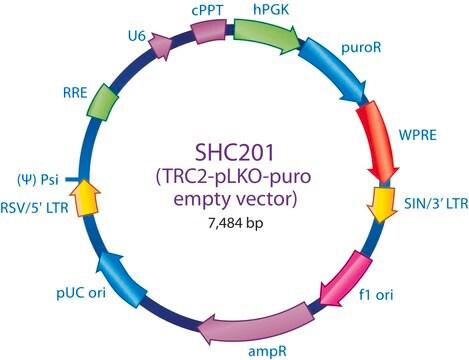SH0531
MISSION® shRNA Human Gene Family Set, Lentiviral Particles
Tumor Suppressors
Anmeldenzur Ansicht organisationsspezifischer und vertraglich vereinbarter Preise
Alle Fotos(1)
About This Item
UNSPSC-Code:
41106609
NACRES:
NA.51
Empfohlene Produkte
Suchen Sie nach ähnlichen Produkten? Aufrufen Leitfaden zum Produktvergleich
Allgemeine Beschreibung
Lentiviral particles (representational, plate titer) are provided in 96-well plates that are barcoded for simple identification. Aliquots of 4 x 50μl are provided to prevent the need for excessive freeze/thaw, and maximize functional viral particles. Each gene family set is representationally titered (10% of clones). Fully titered sets are also available, for more information inquire at RNAi@sial.com. A CD containing RefSeq, gene description, gene symbol, clone ID, hairpin sequence, locus link, and plate map positions are provided with the gene family set.
Anwendung
MISSION® shRNA human gene family set, lentiviral particles has been used in pRb downregulation.
Sonstige Hinweise
Each MISSION shRNA clone is constructed within the lentivirus plasmid vector, pLKO.1-Puro, followed by transformation into Escherichia coli. The pLKO.1-Puro vector contains bacterial (ampicillin) and mammalian (puromycin) antibiotic resistance genes for selection of inserts in either bacterial or mammalian cell lines. Each clone set consists of an average of 3-5 constructs that have been designed against each target gene using a proprietary algorithm. Therefore, a range of knockdown efficiency, with at least one construct from each gene set being >70%, can be expected when using these clones. This allows one to examine the effect of loss of gene function over a large series of gene knockdown efficiencies. Each shRNA construct has been cloned and sequence verified to ensure a match to the target gene.
For a detailed listing of other available gene family sets, visit the gene family set website.
Number of Genes: 73, Number of Clones: 575
The exact gene and clone count at time of purchase may vary slightly as the TRC library is continually updated.
Rechtliche Hinweise
Use of this product is subject to one or more license agreements. For details, please see http://sigmaaldrich.com/missionlicense .
MISSION is a registered trademark of Merck KGaA, Darmstadt, Germany
Lagerklassenschlüssel
12 - Non Combustible Liquids
WGK
WGK 3
Flammpunkt (°F)
Not applicable
Flammpunkt (°C)
Not applicable
Persönliche Schutzausrüstung
Eyeshields, Gloves, multi-purpose combination respirator cartridge (US)
Analysenzertifikate (COA)
Suchen Sie nach Analysenzertifikate (COA), indem Sie die Lot-/Chargennummer des Produkts eingeben. Lot- und Chargennummern sind auf dem Produktetikett hinter den Wörtern ‘Lot’ oder ‘Batch’ (Lot oder Charge) zu finden.
Besitzen Sie dieses Produkt bereits?
In der Dokumentenbibliothek finden Sie die Dokumentation zu den Produkten, die Sie kürzlich erworben haben.
HPV-16 E7 expression up-regulates phospholipase D activity and promotes rapamycin resistance in a pRB-dependent manner.
Rabachini T, et al.
BMC Cancer, 18(1), 485-485 (2018)
Cynthia Osborne et al.
The oncologist, 9(4), 361-377 (2004-07-22)
Carcinogenesis is a multistep process characterized by genetic alterations that influence key cellular pathways involved in growth and development. Oncogenes refer to those genes whose alterations cause gain-of-function effects, while tumor suppressor genes cause loss-of-function effects that contribute to the
Jonathan C Berger et al.
Cancer biology & therapy, 4(8), 805-812 (2005-08-06)
In the past decade, findings from various disciplines of research have stimulated a reevaluation of fundamental concepts of the biology of metastasis. The convergence of two avenues of research has largely been responsible for this shift. First, clinical and experimental
Emanuela Vattemi et al.
Drug news & perspectives, 20(8), 511-520 (2007-12-15)
Cancer formation is a multistep process that involves the sequential activation of oncogenes as well as the inactivation of tumor suppressor genes often in the same clone of cells. These genetic changes generate concomitant phenotypic changes in the tumor cells
Tatiana Rabachini et al.
BMC cancer, 18(1), 485-485 (2018-04-29)
Human Papillomavirus (HPV) infection is the main risk factor for the development and progression of cervical cancer. HPV-16 E6 and E7 expression is essential for induction and maintenance of the transformed phenotype. These oncoproteins interfere with the function of several
Unser Team von Wissenschaftlern verfügt über Erfahrung in allen Forschungsbereichen einschließlich Life Science, Materialwissenschaften, chemischer Synthese, Chromatographie, Analytik und vielen mehr..
Setzen Sie sich mit dem technischen Dienst in Verbindung.






